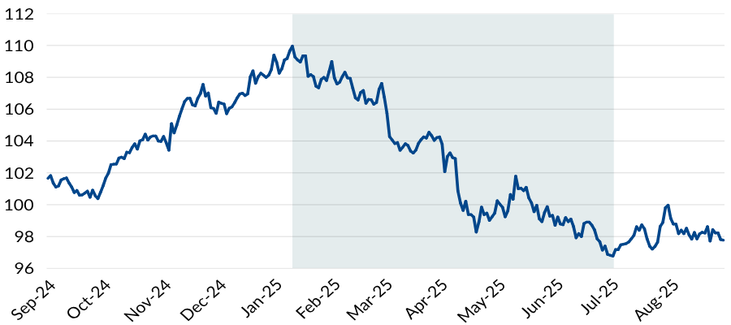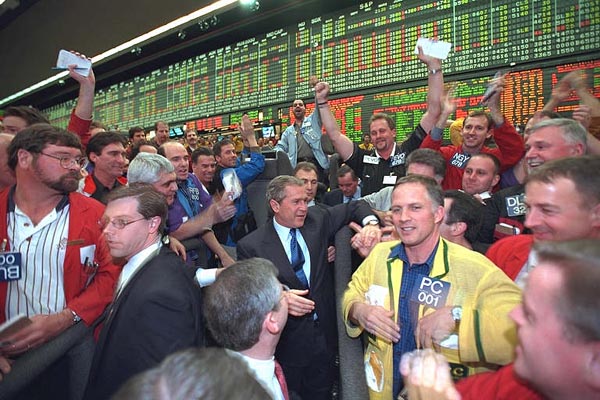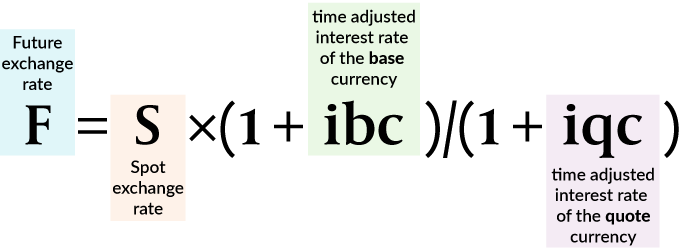Insights
Managing risk with FX futures
Share this article
October 1, 2025
Hedging and speculation with currency futures - understanding the basics
Why currency futures matter
Since September 2024, the US dollar’s value has followed a wild and bumpy path, reaching a peak in January 2025 on post-election optimism surrounding tax reform and deregulation, but then declining roughly 12% by early July (Figure 1).
In fact, a drop this dramatic for the first half of the year hadn’t been seen since 1973 (when the US was in the midst of the Watergate scandal). The dollar bore the brunt of shifting sentiment around trade policy, concerns about reserve currency status, and rising debt levels.
FIGURE 1: DXY SEPTEMBER 2024 – AUGUST 2025

Source: Bloomberg
Currency futures are designed for such volatile environments. These contracts allow market participants to manage currency risk or speculate on exchange rate movements by agreeing today to exchange currencies at a future date and predetermined rate.
What are currency futures?
Currency futures are derivative instruments—contracts whose value is derived from an underlying asset, in this case, a currency pair. The spot exchange rate reflects the current value of one currency relative to another (e.g., €1 = $1.1685).
Currency futures are standardized in terms of contract size, currency pair, expiration date, and minimum price fluctuation. For example, a standard euro futures contract represents €125,000, expires quarterly, and has a minimum price movement equivalent to $6.25.
These contracts are traded on centralized exchanges, which serve two essential functions: they provide transparent pricing by publishing all trades, and they act as the counterparty to every transaction. This structure enhances market integrity and ensures that contractual obligations are met.
Where are currency futures traded?
While futures exchanges operate globally, the Chicago Mercantile Exchange (CME) is the dominant futures venue (Figure 2).
FIGURE 2 : CHICAGO MERCANTILE EXCHANGE

President George W. Bush at Chicago Mercantile Exchange, 6 March 2001, Source: whitehousearchives.gov
CME offers a vast array of futures (e.g. agricultural and energy commodities) and includes a broad array of currency pairs. The CME competes with Atlanta-based Intercontinental Exchange (ICE), Eurex in Europe, and Singapore Exchange (SGX) in Asian markets. Each exchange provides standardized contracts and transparent pricing, with trading available nearly 24 hours a day (see Table 1).
TABLE 1: CURRENCY FUTURES TRADING TIMES BY EXCHANGE
| Exchange | Trading hours (local hours) |
| CME | Sunday 5:00 pm – Friday 4:00 PM CT; daily break 4:00–5:00 pm |
| ICE | Sunday 8:00 pm – Friday 5 pm ET |
| Eurex | Typically 8 am – 10 pm CET |
| SGX | Hours can change slightly for different currency pairs; US dollar/Chinese yuan: 7:25 am – 5:55 pm SGT; evening session 6:15 pm to 5:15 am SGT |
Source: Exchanges
The exchanges offer trading platforms, but traders may also access futures markets through platforms such as Interactive Brokers, E*TRADE, or TradeStation, depending on their experience, trading requirements and analytical needs.
What are the key differences between futures and forwards?
If futures are standard, forwards are custom. Both describe a later date currency exchange, but forwards allow for tailored amounts, dates, and collateral terms.
Futures trade on exchanges; forwards trade over the counter (OTC), often via dealer networks. OTC trading can fragment liquidity and obscure pricing, while futures exchanges offer transparency and centralized pricing. Table 2 presents characteristics of futures and forwards.
TABLE 2: CHARACTERISTICS OF FUTURES AND FORWARDS
| Characteristic | Futures | Forwards |
| Counterparty risk | Low (exchange-backed collateral) | High (some mitigation mechanisms) |
| Trade amount | Standard contract sizes | Custom amounts |
| Trading venue | Exchange | Over the counter - no physical location |
| Delivery date | Standard | Negotiated |
| Collateral | Always required | Sometimes required |
| Settlement | Daily collateral adjustments | On value date |
| Delivery | Usually cash settled | Physical currency exchange |
Source: Mesirow
Pricing and mechanics of currency futures
Currency futures pricing is based on the spot exchange rate and the interest rate differential between the two currencies. The difference between the spot and futures price—known as the basis—can be positive or negative. As the contract approaches expiration, the futures price converges toward the spot rate due to the declining time value of money.
Pricing is governed by the covered interest rate parity equation:
COVERED INTEREST RATE PARITY (CIRP) EQUATION
F = S * (1+ ibc) / (1+iqc) where F is the futures price, S is the spot rate, ibc is the base currency interest rate, and iqc is the quote currency interest rate.

See this spot and forwards article for more information about base and quote currencies and an example using values in the CIRP equation.
Most currency futures are cash settled. If you don’t want to take delivery (like a truckload of wheat), you simply close out the contract before expiration and settle the difference in cash. That’s ideal for traders focused on price movement rather than physical exchange.
Applications: Hedging and speculation
Currency futures are primarily used for hedging and speculative purposes.
Corporations engaged in international trade often hedge against exchange rate fluctuations to protect profit margins. For example, a European firm purchasing US oil may sell euros via futures to lock in the EUR/USD rate. If the euro depreciates, gains on the futures contract offset losses from the spot market transaction.
Speculators use currency futures to express views on exchange rate movements. Leverage—via margin—allows for larger positions with smaller capital outlay, amplifying both potential returns and risks.
Currency futures risks and considerations
Currency futures aren’t without hazards:
Speculation risk | Leveraged losses can trigger a margin call, a demand by the futures exchange to post more collateral.
Event risk | Geopolitical shocks such as the Russian invasion of Ukraine or economic data releases can make currency exchange rates exceptionally volatile.
Basis risk | A futures price that doesn’t perfectly converge with the spot price at the future’s expiration can lead to a discrepancy between the expected hedging outcome and the actual result.
Counterparty risk | Significant in the OTC forwards market, this is a minimal risk in futures because the exchange acts as a central counterparty to all trades, effectively guaranteeing the terms of the contract.
Liquidity risk | The difficulty of entering or leaving a position because of an inadequate number of buyers or sellers can be a problem with low-demand currency pairs. Low trading volumes can lead to slippage, the difference between the expected price and the actual price.
Currency futures can be a valuable tool for managing currency exposure and expressing market views. However, prudent risk management is essential. The disaster that can occur when traders ignore risk is portrayed in the 1983 film Trading Places. It offers a humorous portrayal of still-valid futures trading pitfalls, from all-or-nothing decisions to ignoring margin requirements.
Explore more currency insights
Monetary futures: Stablecoins leap ahead of CBDCs
China, India, and the EU press on with CBDCs, but the US bets big on private crypto innovation.
Stablecoins prepare to enter mainstream payments
President signs legislation to regulate payment stablecoins, but how stable are they?
Spark
Our quarterly email featuring insights on markets, sectors and investing in what matters
